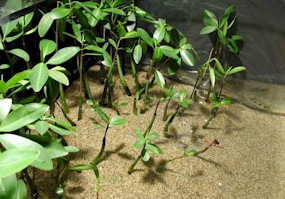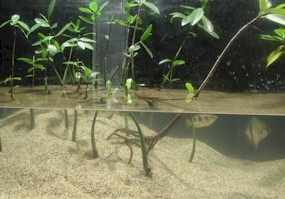|
Coastal
mangrove habitats are a beautiful and vital part of a natural
coastal ecosystem. Submerged roots of mangrove trees
provide safety and habitat for invertebrates and fish,
which require shelter and protection from predators
and strong current. It's here that the submerged
portion of mangrove roots become a nursery for a
variety of macro algae, soft corals, sponges,
tunicates and barnacles. Mangrove roots trap
organic sediment from land during heavy rains, which
keeps near shore waters, coral reefs
and sea grass beds clean. They can help form islands and
are known as land formers because the sand and soil
they trap causes the shoreline to grow.
Although
the amount of marine life in this environment is limited, it
can be an interesting and inspiring aquascape for various marine plants
and soft coral species. Several large
commercial aquariums, as well as a few hobbyists, have
set up exhibits with red mangrove trees to replicate
this unique habitat. Some of the species of marine
plants that are native to this environment include: Caulerpa, Ulva, Codium,
Chaetomorpha and Enteromorpha as well as both black and
white mangroves.
|

|
|
This
brackish water biotope is the work of Lori
Shimoda of Honolulu, Hi. It features variable
sand depths and a colorful assortment of archer
fish and scats. |
|

|
|
The
aquarium measures 96" x 25" x
24", has (2) 150W metal halide 5000K fixtures,
and a fluval 4 canister filter. This impressive,
286 gallon aquarium is filled with roughly 550
lbs of local sand. The aquarium also receives
several hours of indirect sunlight every day. |
|